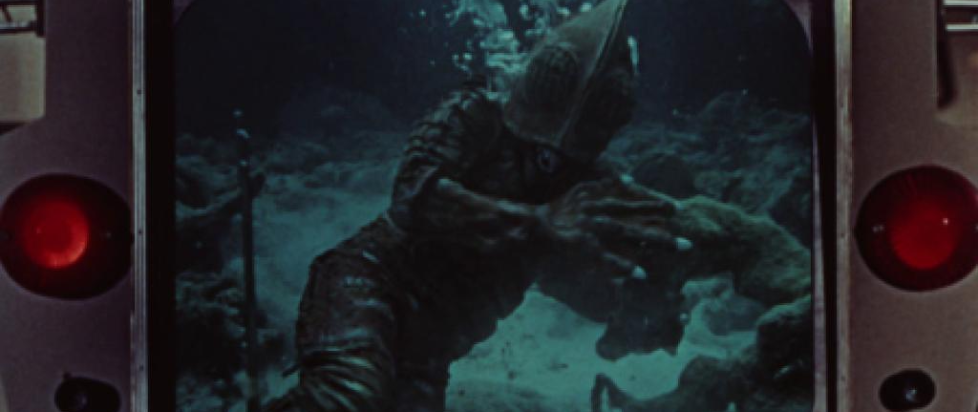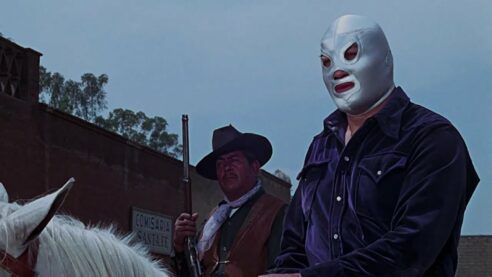
Wrestling and Sex: Three Mexican Wrestling Films from Director Rene Cardona
About this time last year, I wrote about Indicator’s release of the first two movies starring El Santo, the most famous of all masked wrestlers, or luchadores enmascarados. For their second batch of releases along similar lines, Indicator has jumped a considerable distance into the future – and into Santo’s lengthy cinematic pedigree.
Indeed, the only actual El Santo movie in this collection of three wrestling-adjacent titles all directed by the prolific Rene Cardona is something like the “twenty-fifth-or-so installment in a popular series of lucha libre films starring Santo,” according to an essay by Colin Gunckel in the booklet that accompanies the Indicator release of Santo vs. the Riders of Terror.
Released in 1970, Santo vs. the Riders of Terror is actually the last, chronologically, of the three films we’re here to discuss, but it makes a good starting point both due to its connection to that aforementioned string of Santo films with which we are (at least ostensibly) already familiar and because its “generic hybridity” (Gunckel again) helps to point up just what (besides wrestling and Cardona) these three films actually have in common.
“Creating alternative versions of lucha libre films for Europe, and adding sexo to the title, became a common practice for Calderon Productions,” Gunckel writes in that same essay. And while all three of the films that we’re discussing today may not have been released in alternate cuts with sexo in the title, all three are definitely films that are skirting Mexican censors of the late ‘60s and using sex appeal to help sell their stories of masked wrestlers, lycanthropes, mad science, swinging spies, and… lepers?
“To hell with pity and good conscience.” – Santo vs. the Riders of Terror (1970)
Also released under the unlikely title Lepers and Sex, Santo vs. the Riders of Terror is, on paper, one of the strangest genre hybrids you could ever imagine. As I said on Letterboxd immediately after watching it, I would have dearly loved to have been present for the pitch meeting that decided to make an El Santo movie that was:
- Fully a period Western.
- A softcore sex romp.
- About lepers.
While the booklet accompanying the Blu provides copious context and speculation regarding how such a dissonant combination may have come to pass, it can really only go so far toward explaining away what is, without a doubt, one of the most unusual in a passel of almost uniformly unusual lucha libre pictures.

The movie opens with six lepers escaping from what the subtitles dub a “leper hospital.” This terrifies the residents of a nearby town in what is apparently supposed to be the American southwest at the end of the 19th century but looks, as Gunckel points out, like “the Universal backlot.” The townsfolk become hysterical with fear over contagion, and a group of unscrupulous local bandits use that hysteria as a smokescreen for a series of robberies, posing as lepers themselves.
As the robberies continue and the townspeople come dangerously close to taking the law into their own hands via the (admittedly extreme) recourse of burning down the leper hospital, the local sheriff sends for El Santo, who shows up fully in his mask, of course, despite this apparently being the 1800s and not the era of his usual films – or a time when masked wrestlers really existed yet.
This is all in the regular cut of the film, the one released under the title Santo vs. the Riders of Terror. The sexo cut, under the not-especially-titillating moniker Lepers and Sex, is identical in every other respect but adds in three lengthy softcore sex scenes, one of which clocks in at around 2 minutes, and all of which include copious nudity. There’s even a bit of dong in one, where the sheriff also appears to perform oral sex (albeit briefly) on his fiancé.
“It’s hard to describe her with words.” – The Bat Woman (1968)
Released two years before Santo vs. the Riders of Terror, the “generic hybridity” of The Bat Woman is less jarring only because those of us who watch these types of films are accustomed to them jamming together crime capers, mad scientists, wrestling, spy shenanigans, and monsters – all of which are very much present here.
No apparent relation to Jerry Warren’s notorious 1966 film The Wild World of Batwoman – made infamous by its presentation as an episode of Mystery Science Theater 3000 – The Bat Woman is, instead, “typical of a kind of popular Mexican genre cinema that flourished in Mexico in the late fifties and throughout the sixties,” according to Dolores Tierney, writing in the booklet that accompanies the Indicator Blu.
As Tierney points out, these films “borrowed significantly from the conventions and iconographies of Hollywood movies.” Or, in this case, the popular Batman television series starring Adam West, which ran from 1966 through 1968, and got a movie of its own in ’66.
In keeping with the sex appeal theme that connects all three of the films we’re here to discuss, our bat hero has been gender-swapped and, when she’s not wrestling, wears a much skimpier costume consisting of a cowl, a short cape, and a bikini. Much like El Santo, the Bat Woman wears a mask to hide her identity (though unlike that masked wrestler, who had to keep his identity secret from the moviegoing public as well, we often see her without it) and seems to already be known to most of the characters in the movie before she ever shows up.
Like Batman, she is a wealthy crimefighter, and like El Santo, she gets very little origin story, except to say that she is a champion of justice and that, “Thanks to her unique skills, she has mastered all types of sports.” We see this in a montage which includes her shooting, horseback riding, scuba diving, and, of course, wrestling.
Despite this fob toward equality, Bat Woman does not quite enjoy the same sort of treatment that Santo would get in a similar picture. She may be an immensely capable character, but her status as a member of the fairer sex also means that the film sometimes utilizes her differently than they would her male counterparts. While Santo might get captured by the bad guys, for example, he would never faint just because a fishman grabbed him.
Speaking of the fishman, that’s the central plot of the movie. Its villain is a mad scientist on board a yacht called the Reptilicus who, like Bela Lugosi in Bride of the Monster, is obsessed with creating a “rice of pipples,” to quote Mike from Mystery Science Theater 3000.
In this case, that’s a singular, somewhat inexplicably red fishman who looks like a cross between the Creature from the Black Lagoon and a Sleestak. In her essay, Tierney also tries to argue that the “amphibious man [Guillermo] del Toro designed for The Shape of Water bears a remarkable resemblance to Piscis, the fish-man Dr. Williams is able to successfully create in The Bat Woman,” though I think that’s maybe a bit of a stretch.
“This has a logical explanation that stretches back to the time of the wizards.” – The Panther Women (1967)

The earliest of the three films we’re here to discuss – and the only one shot in black-and-white – Panther Women is also the one that’s going to feel most familiar to anyone who has ever watched one of these kinds of films before. Indeed, the plot and beats of Panther Women are pretty much identical to films such as The World of the Vampires (1961) and Santo vs. the Vampire Women (1962), which was dubbed and released in the States as Samson vs. the Vampire Women, where it achieved minor fame via Mystery Science Theater 3000.
Where both of those flicks revolved around vampires, however, the villains in The Panther Women are a cult of lycanthropic women who can turn into, well, I think the title makes it fairly obvious. It seems that a long time ago, the high priest of their Bast-worshipping cult was slain by a druid – as is so often the way – and now they have to hunt down all of the druid’s descendants so that the high priest can come back from the dead as an actually pretty gnarly looking leprous revenant.
Fortunately for the forces of good – who include two lady wrestlers, a police captain, his cowardly assistant, and a knock-off El Santo called the Angel – the villains are actually quite bad at their task, especially the aforementioned lich of a high priest, who bumbles hopelessly through everything that he attempts to accomplish.
Aside from the eponymous shapeshifters, the thing that sets Panther Women apart from the other films I cited up above – not to mention any number of other, similar flicks – is its focus on luchadoras, or women wrestlers. Indeed, The Panther Women is the fourth in what an essay by Iain Robert Smith included with the Indicator Blu calls “the luchadoras cycle,” all directed by Rene Cardona and including such titles as Doctor of Doom, The Wrestling Women vs. the Aztec Mummy, and She-Wolves of the Ring. (The latter is not, as one might expect, about werewolves to go with this film’s were-panthers.)
Was The Panther Women actually the best of these three movies? It has too many interminable wrestling scenes and sequences of people driving cars at reasonable speeds to make a definitive claim in that direction. But I like gothic nonsense better than I like Western nonsense or swinging super spy nonsense, so it just might have been my favorite. Good to know that I’ve got at least four other “wrestling women” movies waiting for me out there one of these days, just as it is good to know that Indicator is continuing to put this kind of effort into making these titles available and preserving them for posterity.
———
Orrin Grey is a writer, editor, game designer, and amateur film scholar who loves to write about monsters, movies, and monster movies. He’s the author of several spooky books, including How to See Ghosts & Other Figments. You can find him online at orringrey.com.





